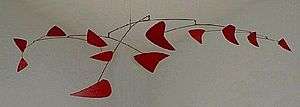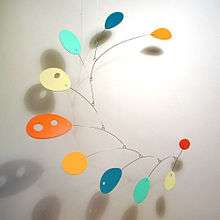Mobile (sculpture)
A mobile (UK: /ˈmoʊbaɪl/,[1]US: /ˈmoʊbiːl/)[2] is a type of kinetic sculpture constructed to take advantage of the principle of equilibrium. It consists of a number of rods, from which weighted objects or further rods hang. The objects hanging from the rods balance each other, so that the rods remain more or less horizontal. Each rod hangs from only one string, which gives it the freedom to rotate about the string. An ensemble of these balanced parts hang freely in space, by design without coming into contact with each other.


Mobiles are popular in the nursery, where they hang over cribs to give infants entertainment and visual stimulation. Mobiles have inspired many composers, including Morton Feldman and Earle Brown who were inspired by Alexander Calder's mobiles to create mobile-like indeterminate pieces.[3] John Cage wrote the music for the short film Works of Calder that focused on Calder's mobiles. Frank Zappa also claimed that his compositions were modelled on Calder mobiles.[4]
Origin
The meaning of the term "mobile" as applied to sculpture has evolved since it was first suggested by Marcel Duchamp in 1931 to describe the early, mechanized creations of Alexander Calder.[5] At this point, "mobile" was synonymous with the term "kinetic art", describing sculptural works in which motion is a defining property. While motor or crank-driven moving sculptures may have initially prompted it, the word "mobile" later came to refer more specifically to Calder's free-moving creations. Influenced by the abstract work of Piet Mondrian, Joan Miró and Sophie Taeuber-Arp, Calder in many respects invented an art form where objects (typically brightly coloured, abstract shapes fashioned from sheet metal) are connected by wire much like a balance scale. By the sequential attachment of additional objects, the final creation consists of many balanced parts joined by lengths of wire whose individual elements are capable of moving independently or as a whole when prompted by air movement or direct contact. Thus, "mobile" has become a more well-defined term with its origin in the many such hanging constructs Calder produced in a prolific manner between the 1930s and his death in 1976.
Similar works
Calder's work is the only one defined by the term "mobile"; however, three other notable artists worked on a similar concept. Man Ray experimented with this idea around 1920, Armando Reverón who during the 30s made a series of movable skeletons and Bruno Munari created his "Useless Machines" in 1933, made in cardboard and playful colors.[6]
See also
References
- http://www.oxforddictionaries.com/definition/english/mobile
- American Heritage Dictionary
- Kenneth Silverman (2012). Begin Again: A Biography of John Cage. Northwestern University Press. p. 187. ISBN 978-0-8101-2830-9.
- Frank Zappa; Peter Occhiogrosso (1990). Real Frank Zappa Book. Simon and Schuster. pp. 162–163. ISBN 978-0-671-70572-5.
- Tomkins, Calvin: Duchamp: A Biography, pages 294. Henry Holt and Company, Inc., 1996. ISBN 0-8050-5789-7
- Munari, Bruno: Air Made Visible, 288 pages, Lars Müller Publishers, 2001. ISBN 978-3-907044-89-6
External links
| Wikimedia Commons has media related to Mobiles. |
- Alexander Calder's Mobiles by Jean-Paul Sartre, Les Temps Modernes, 1963